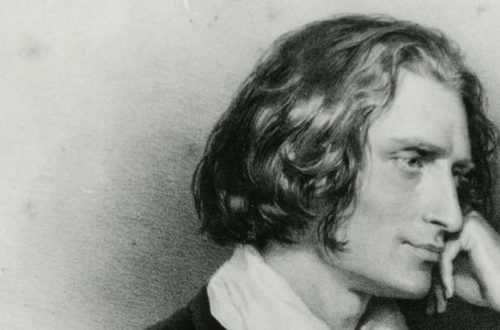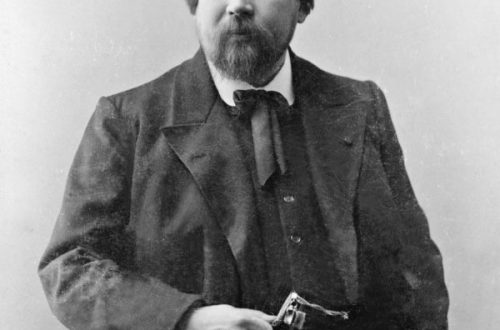
Gara Garayev |
Gara Garayev
In his youth, Kara Karaev was a desperate motorcyclist. The furious race answered his need for risk, for gaining a sense of victory over himself. He also had another, completely opposite and preserved for life, “quiet” hobby – photography. The lens of his apparatus, with great accuracy and at the same time expressing the personal attitude of the owner, pointed at the world around – snatched the movement of a passerby from a crowded city stream, fixed a lively or thoughtful look, made the silhouettes of oil rigs rising from the depths of the Caspian “talk” about the current day, and about the past – dry branches of the old Apsheron mulberry tree or the majestic buildings of Ancient Egypt …
It is enough to listen to the works created by the remarkable Azerbaijani composer, and it becomes clear that Karaev’s hobbies are only a reflection of what is so characteristic of his music. The creative face of Karaev is characterized by a combination of bright temperament with precise artistic calculation; variety of colors, richness of the emotional palette – with psychological depth; interest in topical issues of our time lived in him along with interest in the historical past. He wrote music about love and struggle, about the nature and soul of a person, he knew how to convey in sounds the world of fantasy, dreams, the joy of life and the coldness of death …
Masterfully mastering the laws of musical composition, an artist of a brightly original style, Karaev, throughout his entire career, strove for a constant renewal of the language and form of his works. “To be on a par with the age” – such was the main artistic commandment of Karaev. And just as in his younger years he overcame himself in a fast ride on a motorcycle, so he always overcame the inertia of creative thought. “In order not to stand still,” he said in connection with his fiftieth birthday, when international fame had long been behind him, “it was necessary to“ change ”oneself.”
Karaev is one of the brightest representatives of D. Shostakovich’s school. He graduated in 1946 from the Moscow Conservatory in the composition class of this brilliant artist. But even before becoming a student, the young musician deeply comprehended the musical creativity of the Azerbaijani people. In the secrets of his native folklore, ashug and mugham art, Garayev was introduced to the Baku Conservatory by its creator and the first professional composer of Azerbaijan, U. Hajibeyov.
Karaev wrote music in various genres. His creative assets include compositions for musical theatre, symphonic and chamber-instrumental works, romances, cantatas, children’s plays, music for drama performances and films. He was attracted by themes and plots from the life of the most diverse peoples of the globe – he deeply penetrated the structure and spirit of the folk music of Albania, Vietnam, Turkey, Bulgaria, Spain, African countries and the Arab East … Some of his compositions can be defined as milestones not only for his own creativity, but also for Soviet music in general.
A number of large-scale works are devoted to the theme of the Great Patriotic War and were created under the direct impression of the events of reality. Such is the two-part First Symphony – one of the first works of this genre in Azerbaijan (1943), it is distinguished by sharp contrasts of dramatic and lyrical images. In the five-movement Second Symphony, written in connection with the victory over fascism (1946), the traditions of Azerbaijani music are fused with those of classicism (an expressive 4-movement passacaglia is based on mugham-type thematics). In 1945, in collaboration with D. Gadzhnev, the opera Veten (Motherland, lib. by I. Idayat-zade and M. Rahim) was created, in which the idea of friendship between the Soviet peoples in the struggle for the liberation of the Motherland was accentuated.
Among the early chamber works, the piano painting “The Tsarskoye Selo Statue” (after A. Pushkin, 1937) stands out, the originality of the images of which was determined by the synthesis of folk-national intonation with the impressionistic colorfulness of the texture; Sonatina in A minor for piano (1943), where national expressive elements are developed in line with Prokofiev’s “classicism”; The Second String Quartet (dedicated to D. Shostakovich, 1947), notable for its light youthful coloring. Pushkin’s romances “On the Hills of Georgia” and “I Loved You” (1947) belong to the best works of Karaev’s vocal lyrics.
Among the works of the mature period is the symphonic poem “Leyli and Majnun” (1947), which marked the beginning of lyric-dramatic symphony in Azerbaijan. The tragic fate of the heroes of Nizami’s poem of the same name was embodied in the development of the sorrowful, passionate, sublime images of the poem. The plot motifs of Nizami’s “Five” (“Khamse”) formed the basis of the ballet “Seven Beauties” (1952, script by I. Idayat-zade, S. Rahman and Y. Slonimsky), in which a picture of the life of the Azerbaijani people in the distant past, its heroic struggle against the oppressors. The central image of the ballet is a simple girl from the people, her self-sacrificing love for the weak-willed Shah Bahram contains a high moral ideal. In the struggle for Bahram, Aisha is opposed by the images of the insidious Vizier and the seductively beautiful, ghostly seven beauties. Karaev’s ballet is a brilliant example of combining the elements of Azerbaijani folk dance with the symphonic principles of Tchaikovsky’s ballets. The bright, multicolored, emotionally rich ballet The Path of Thunder (based on the novel by P. Abrahams, 1958), in which the heroic pathos is associated with the struggle of the peoples of Black Africa for their independence, is interesting for the masterfully developed musical and dramatic conflict, the symphony of Negro folklore elements (the ballet was the first piece of Soviet music to develop African folk music on such a scale).
In his mature years, Karaev’s work continued and developed a tendency to enrich Azerbaijani music with classicist means of expression. The works where this trend is especially prominent include the symphonic engravings Don Quixote (1960, after M. Cervantes), permeated with Spanish intonation, a cycle of eight pieces, in the sequence of which the tragically beautiful image of the Knight of the Sad Image emerges; Sonata for violin and piano (1960), dedicated to the memory of the mentor of childhood, the wonderful musician V. Kozlov (the finale of the work, a dramatic passacaglia, is built on his sound anagram); 6 last pieces from the cycle of 24 “preludes for piano” (1951-63).
The folk-national style was synthesized with great skill from the classic style in the Third Symphony for Chamber Orchestra (1964), one of the first major works of Soviet music created using the method of serial technique.
The theme of the symphony – a man’s reflections “about time and about himself” – is multifacetedly refracted in the energy of the action of the first part, in the iridescent sonority of the ashug chants of the second, in the philosophical reflection of Andante, in the enlightenment of the coda, dispelling the unkind irony of the final fugue.
The use of diverse musical models (borrowed from the 1974th century and modern ones associated with the “big beat” style) determined the dramaturgy of the musical The Furious Gascon (1967, based on Cyrano de Bergerac by E. Rostand) about the famous French freethinker poet. Karaev’s creative heights also include the Violin Concerto (12, dedicated to L. Kogan), filled with high humanity, and the cycle “1982 Fugues for Piano” – the composer’s last work (XNUMX), an example of deep philosophical thought and brilliant polyphonic mastery.
The music of the Soviet master is heard in many countries of the world. The artistic and aesthetic principles of Karaev, a composer and teacher (for many years he was a professor at the Azerbaijan State Conservatory), played a huge role in the formation of the modern Azerbaijani school of composers, numbering several generations and rich in creative personalities. His work, which organically melted the traditions of national culture and the achievements of world art into a new, original quality, expanded the expressive boundaries of Azerbaijani music.
A. Bretanitskaya





